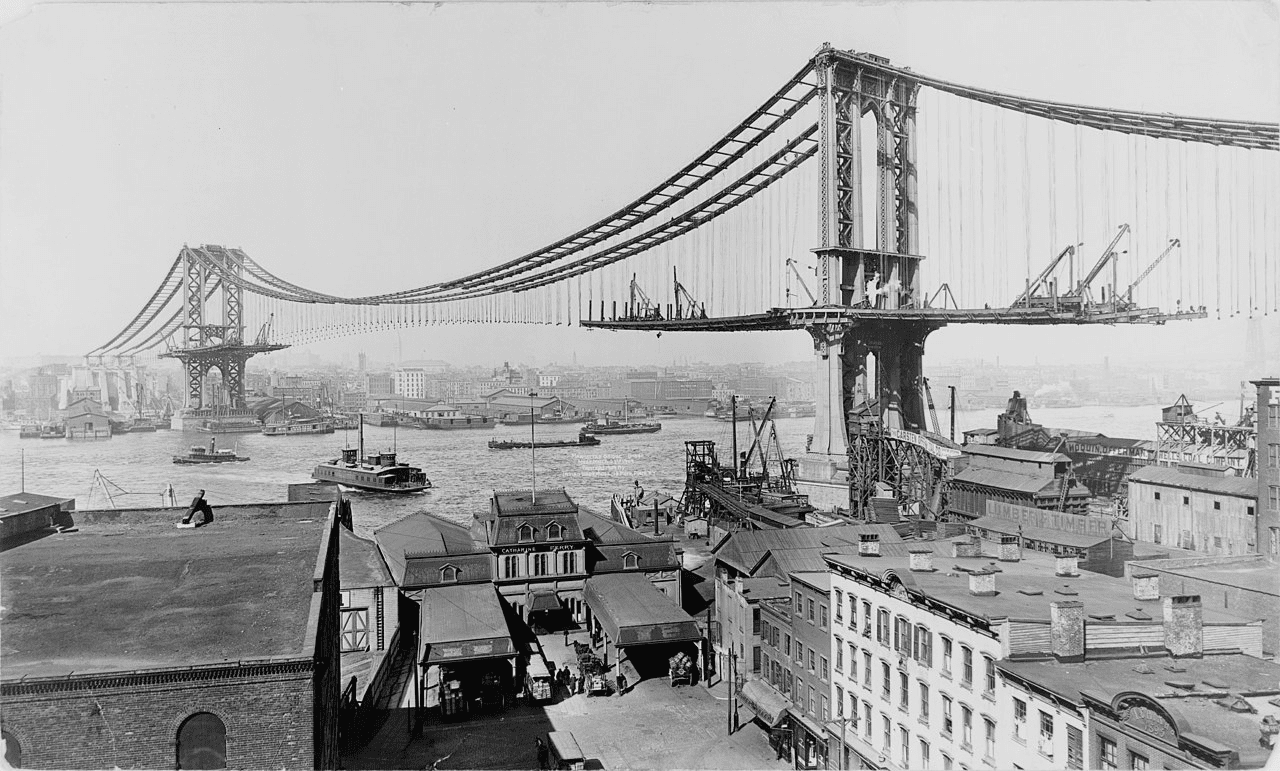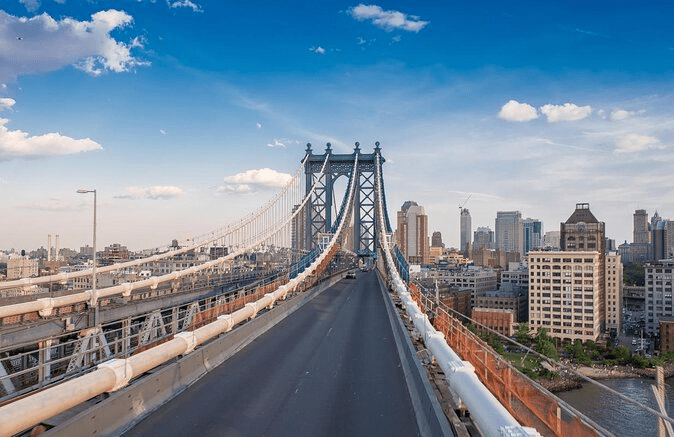This article is about one of four free suspension vehicular bridges connecting Manhattan Island and Long Island. It was designed by lead engineer Leon Moisseiff and is 6,855 feet (2,089 m) long. Read more about it on manhattan-future.

Foundation and construction
The Manhattan Bridge is a suspension bridge that crosses the East River, connecting Lower Manhattan on Canal Street with downtown Brooklyn on Flatbush Avenue.
The first project was developed by R. S. Buck. His plan was a carbon wire cable-stayed suspension bridge supported by a pair of eight-pillar towers. This design would consist of a main span 1,470 feet (450 m) long and approaches 725 feet (221 m) long each. Overpass and trolleybus routes were supposed to pass through this bridge.
In 1901, the city government approved the project. The land was purchased and the contract was signed the same year. It was called Bridge No. 3. In 1902, it received its modern name, the Manhattan Bridge, and the building started. It ended in January 1904.
Additional construction delays occurred during this period. The reason was the disagreement of the municipal commission regarding the plans. Engineer Gustav Lindenthal and architect Henry Hornbostel proposed a novel plan but it was rejected. The new project was presented by the leading engineer Leon Moisseiff. After that, disputes continued for some time, especially related to the material of the cables.
Construction of anchorages began in 1905. Materials were transported using barges. The production of metal structures was carried out by Phoenix Bridge Company. To speed up the process, Manhattan Borough President Bird Sim Coler introduced night shifts and increased the volume of metal fabrication. The bridge towers were completed in 1908. After the main cables were tensioned, there were concerns about the safety. The Glyndon Construction Company subsequently installed vertical suspension cables to strengthen the structure. The bridge was officially opened on December 31, 1909. After that, there was still some work to be done. The total cost was about $26 million.

Further history
Transport, including trams, began to run over the bridge in 1912. In 1915, the subway tracks were opened. In 1920, the flow of traffic was large enough, with 27,000 cars passing through it every day. Thus, the management decided to build the eastern upper part of the roadway, which cost $300,000. It was opened in June 1922. To ease traffic on the Manhattan side, left-hand traffic was introduced on the lower level in the 1920s.
In the mid-1900s, the city management decided to replace the trolleybus tracks with a carriageway. Lighting was also installed during this period. Later, even more traffic began to use the bridge, already almost 65 thousand.
In the 1941s, the figure increased to approximately 90,000 cars. During World War II, an air raid siren was installed here. In 1951, during the Cold War, floodlights and barbed wire fences were installed near the foundations of the piers. The latter were sealed to prevent sabotage.
In the 1950s, the bridge underwent reconstruction. The main cause for this was a crack in the girder on the eastern side. Restoration works cost $30 million. At the end of the 20th and the beginning of the 21st century, another large-scale renovation took place. It was caused by cracks due to the weight of the metro trains. It was repeatedly delayed because the reconstruction process revealed serious structural problems. The process was completed around 2004. In 2009, a solemn celebration of the centenary of the bridge took place. There was a parade in the afternoon and fireworks in the evening. In 2009, the American Society of Civil Engineers designated the bridge as a Historic Civil Engineering Landmark.

Facts about the construction
As we mentioned above, the bridge was designed by Leon Moisseiff. It is 6,855 feet (2,089 m) long, 134 feet (40.8 m) high and 120 feet (37 m) wide. The main span between the two suspension towers is 1,470 feet (450 m) long and the side spans, between the anchor piers and the suspension towers on either side, are 725 feet (221 m).
The Paris gate Porte Saint-Denis was taken as the basis for the construction of the arch. As for the design, the arch and colonnade are made of white fine-grained Hallowell granite and are decorated with two groups of allegorical sculptures. On the northern side of the arch, the opening is framed by carved images of classic ships, shields and oak leaves. On the western pier, there is a sculptural group Spirit of Commerce, on the eastern – Spirit of Industry. The arch cornerstone has the image of a bison. The relief is crowned with teeth. On the cornice of the arch are modillions, as well as six lion heads. The southern side of the bridge is less elaborately decorated.
The colonnade and piazza were modeled after the colonnade surrounding St. Peter’s Square in the Vatican. The colonnade rises 38 feet (12 m) high and has an elliptical shape. It is supported on either side by six pairs of 31-foot (9.4 m) Tuscan columns. Above each of them is a stone, an entablature, as well as a cornice and a balustrade.